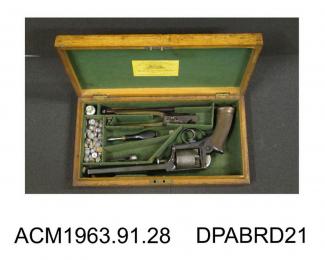Until the arrival of Samuel Colt at the Great Exhibition of 1851 with his display of percussion revolvers, British gun makers had largely neglected this style of weapon except for pepperbox revolvers. The arrival of the brash Colt with his American methods of promoting business caused much resentment in the British gun trade. His weapons were criticised and there was much debate, however the outcome was a surge in revolver design and production by British makers.
One of the most prominent in this field was Robert Adams who had been granted a revolver patent in February 1851. The differences between Adams and Colt revolvers were two fold. On Colt revolvers of this period the barrel was separate from the frame but on Adams' revolvers barrel and frame formed one complete unit and the frame enclosed the cylinder with a top strap, something that was not used on the Colt. The other major difference between Adams early revolvers and Colts was in the method of firing. Colt revolvers were made so that the hammer had to be cocked i.e. pulled back manually between shots. Adams revolvers were designed so that pressing the trigger cocked the hammer and, if pressure was maintained fired the shot.
This fine, cased, Adams self-cocking revolver fires a large .50 calibre bullet, which would have had considerable stopping power. Inside the lid is a trade label for the firm of Deane, Adams and Deane - Robert Adams was manager of the firm. The long barrel would have given the bullet greater velocity and would also help improve accuracy. The hammer has no spur or projection so that it cannot be pulled back by hand but only by means of the trigger.
The case holds a double bullet mould, a metal oil bottle, a nipple key, which also holds a pricker, to clear any deposit in the nipples and a cleaning and loading rod. The other tool is a punch for cutting circular wads to go into the chambers to hold the powder in place.
There was much debate as to which was the better system, Colt or Adams. Various test shoots were carried out and results seemed to suggest that the Adams pistol was the better weapon. However the Colt pistol was certainly the more popular, probably because it was cheaper.
Object number: ACM1963.91.28



